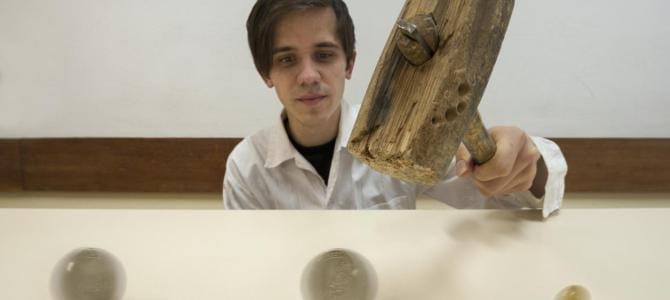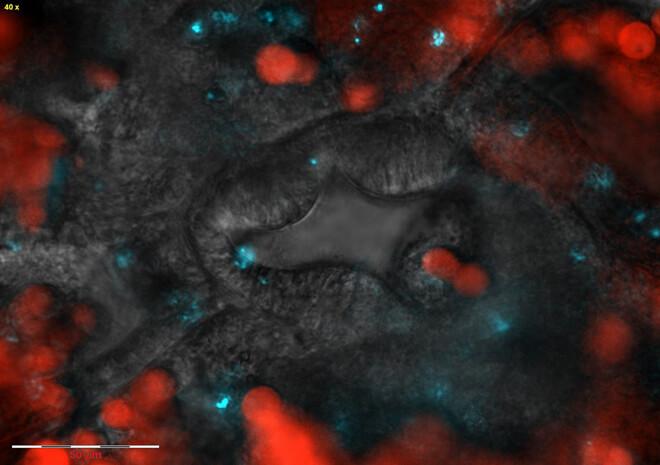
An international team of scientists has set a new record for the complexity possible on a quantum computing chip, bringing us one step closer to the ultra-secure telecommunications of the future.
A key component of quantum science and technology is the notion of entangled particles – typically either electrons or particles of light called photons. These particles remain connected even if separated over large distances, so that actions performed by one affect the behaviour of the other.
In a paper, published today in the journal Science, the research team outlines how it created entangled photon states with unprecedented complexity and over many parallel channels simultaneously on an integrated chip.
Importantly, the chip was also created with processes compatible with the current computer chip industry, opening up the possibility of incorporating quantum devices directly into laptops and cell phones.
The researchers were led by Professor David Moss, the newly appointed Director of the Centre for Micro-Photonics at Swinburne University of Technology, and Professor Roberto Morandotti from the Institut National de la Recherche Scientifique (INRS-EMT) in Montreal, Canada.
The researchers used ‘optical frequency combs’ which, unlike the combs we use to detangle hair, actually help to ‘tangle’ photons on a computer chip.
Their achievement has set a new record in both the number and complexity of entangled photons that can be generated on a chip to help crack the code to ultra-secure telecommunications of the future.
It also has direct applications for quantum information processing, imaging, and microscopy.
“This represents an unprecedented level of sophistication in generating entangled photons on a chip,” Professor Moss says.
“Not only can we generate entangled photon pairs over hundreds of channels simultaneously, but for the first time we’ve succeeded in generating four-photon entangled states on a chip.”
Professor Morandotti says the breakthrough is the culmination of 10 years of collaborative research on complementary metal–oxide–semiconductor (CMOS) compatible chips for both classical and quantum nonlinear optics.
“By achieving this on a chip that was fabricated with processes compatible with the computer chip industry we have opened the door to the possibility of bringing powerful optical quantum computers for everyday use closer than ever before,” Professor Morandotti says.
The groundwork for the research was completed while Professor Moss was at RMIT. The collaboration includes the City University of Hong Kong, University of Sussex and Herriot Watt University in the UK, Yale University, and the Xi’an Institute in China.
Learn more: Record setting leap towards ultra-secure communication
The Latest on: Quantum computing chip
[google_news title=”” keyword=”quantum computing chip” num_posts=”10″ blurb_length=”0″ show_thumb=”left”]
via Google News
The Latest on: Quantum computing chip
- Confused by the quantum computing race? It’s just like the Oscarson May 7, 2024 at 12:00 pm
Plenty of entrepreneurs and scientists have hitched their hopes to the proverbial sandworm of silicon quantum computing. Proponents say this method will be the fastest to scale up because it builds on ...
- Australia raises eyebrows by splashing A$1bn into US quantum-computing start-up PsiQuantumon May 7, 2024 at 8:16 am
The Australian government has controversially announced it will provide A$940m (£500m) for the US-based quantum-startup PsiQuantum. The investment, which comes from the country’s National Quantum ...
- Million qubits chip a possibility, could enable practical quantum computerson May 7, 2024 at 5:28 am
The breakthrough opens the door to integrating millions of qubits on a single chip using mature manufacturing processes. For practical quantum computers to become a reality, breakthroughs like this ...
- New super-pure silicon chip opens path to powerful quantum computerson May 7, 2024 at 2:00 am
Researchers at the Universities of Melbourne and Manchester have invented a breakthrough technique for manufacturing highly purified silicon that brings powerful quantum computers a big step closer.
- 3 Quantum Stocks That Will Make You the Envy of Wall Streeton May 6, 2024 at 12:00 am
It established a dedicated center for quantum computing on Caltech’s campus. In FY2023, Amazon allotted 14.89% of its revenue to R&D, which contributed to developing its in-house fabrication of a ...
- Experiment opens door for millions of qubits on one chipon May 5, 2024 at 5:00 pm
The breakthrough opens up the possibility of integrating millions of these qubits on a single chip using mature manufacturing processes. The race to build a practical quantum computer is well underway ...
- Better Quantum Computing Stock: IBM vs. IonQon May 5, 2024 at 12:02 pm
IBM is growing slower than IonQ and hasn't generated significant revenue from its quantum computing systems yet. However, it's firmly profitable and supporting the future growth of its quantum ...
- The quantum computing race is onon May 5, 2024 at 6:00 am
Although scientists don’t completely understand the underlying science of quantum mechanics, a global geopolitical, military and commercial race is on for the development of affordable and reliable ...
- The $1 Billion Bet on Quantum Computers That Process Lighton April 30, 2024 at 12:30 pm
PsiQuantum wants to make quantum computers in the same way as microchips are made today. So how is it doing?
- Quantum computing breakthrough could happen with just hundreds, not millions, of qubits using new error-correction systemon April 29, 2024 at 4:00 am
Scientists have designed a physical qubit that behaves as an error-correcting "logical qubit," and now they think they can scale it up to make a useful quantum computer using a few hundred.
via Bing News










